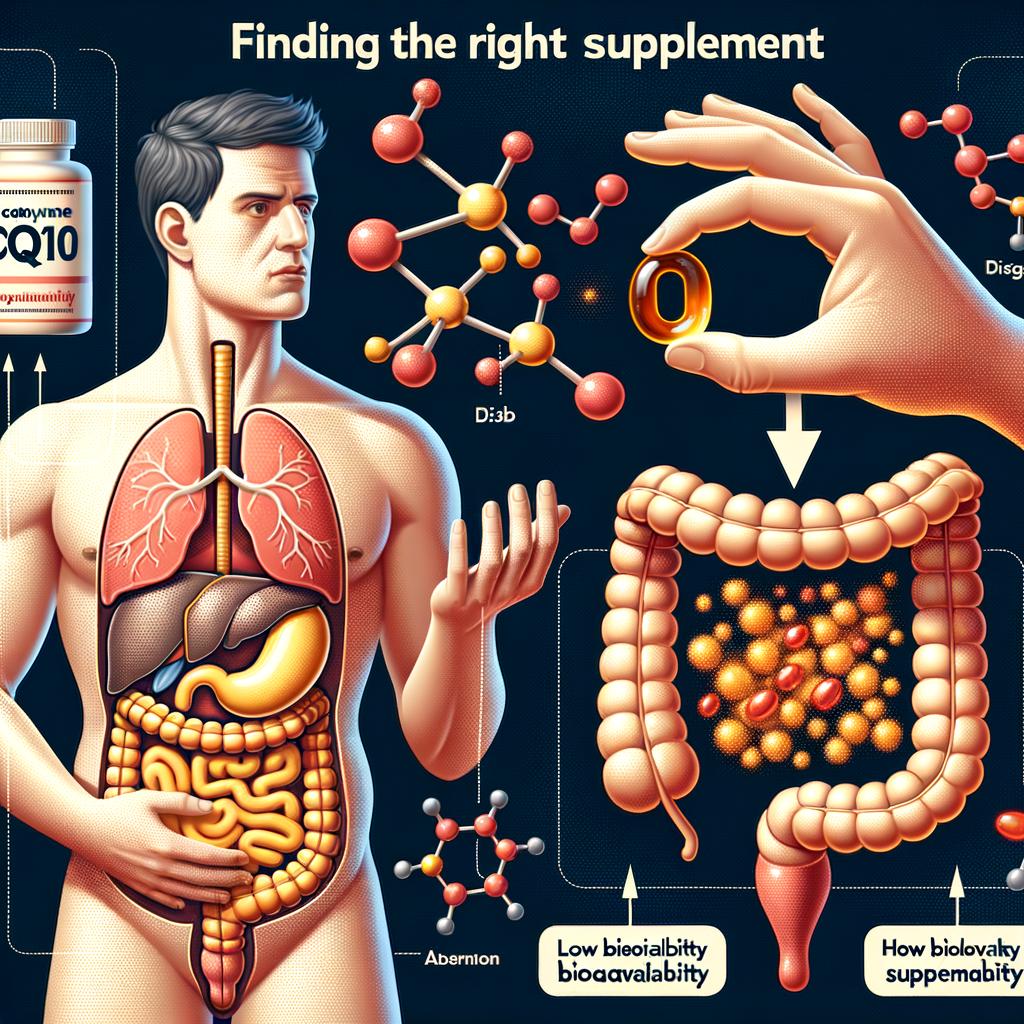Delving into the whirlwind of supplements can leave you spinning with unanswered questions. CoQ10 buffets this storm, but with varying forms and copious supplement options, it may seem a little daunting to select the right one. How can you ensure its effective absorption in the body? What are the differences between its diverse types – ubiquinone and ubiquinol? The YouTube video “Unraveling the Top CoQ10 Supplements” provides insightful answers to all these curiosities. This blog post unfolds a comprehensive review of this video, digging into the science behind CoQ10, discussing its absorption strategies, and shedding light on the quandary between ubiquinone and ubiquinol. Let’s embark on this exploratory journey to find your ideal CoQ10 supplement.
Table of Contents
- Understanding CoQ10’s Absorption Dilemma: Finding the Right Supplement
- Unleashing the Absorption Potential: Emulsified CoQ10 and Omega-3
- Decoding the Two Forms of CoQ10: Ubiquinone Vs Ubiquinol
- Tailoring Your CoQ10 Intake: Identifying the Right Dose and Form per Individual Health Conditions
- Q&A
- To Conclude
Understanding CoQ10’s Absorption Dilemma: Finding the Right Supplement

In order to choose the optimal CoQ10 supplement, comprehending the attributes of CoQ10 molecules is pivotal. The CoQ10 molecules are usually quite large and our bodies cannot absorb them effortlessly. Hence, while zeroing in on a supplement, it is crucial to find a product that devises a methodology to enhance the absorption.
Now let’s delve into the various strategies employed to increase the absorption of CoQ10. The most favored and effective way is through the process of emulsification. By combining CoQ10 with a fat like fish oil, it increases not only the supplement’s bioavailability but also provides an additional health boon in the forms of omega-3 fatty acids.
| CoQ10 Forms | Price | Recommended For |
|---|---|---|
| Ubiquinone | Less Expensive | General Population |
| Ubiquinol | More Expensive | Elderly people or those with certain health conditions |
Now moving onto the types of CoQ10 available as supplements, they are ubiquinone and ubiquinol. Ubiquinone is the oxidized inactive form, while ubiquinol is the reduced active form of CoQ10. One would naturally tend to consider ubiquinol due to its active nature, however, our bodies can readily convert between the two forms. Indeed, after ingestion of ubiquinone, our body immediately converts it to ubiquinol for usage and can switch it back to ubiquinone as needed. Therefore, it is often recommended to consume ubiquinone instead of ubiquinol.
Though ubiquinol is slightly costlier than ubiquinone, there are specific categories of people who could benefit more from ubiquinol, namely seniors and certain chronically ill individuals. As we grow older, the conversion from ubiquinone to ubiquinol within our bodies tends to slow down. And for those with specific genetic factors or diseases, the conversion process can be somewhat lethargic. Hence, for those individuals, it is more beneficial to consume ubiquinol.
It has been found that on average, most people would benefit from an intake of between 50 to 200mg of an emulsified ubiquinone supplement.
Unleashing the Absorption Potential: Emulsified CoQ10 and Omega-3

CoQ10, with its considerable size and poor absorption, needs a helping hand to deliver its benefits effectively in our bodies. It’s crucial to look for a supplement that integrates a more effective method to boost its absorbability, otherwise users may not fully gain the rewards of this power-packed molecule. The method to watch out for when on the supplement-hunting path? Emulsification.
Combining CoQ10 with a fat is a nifty way to enhance its absorption and bioavailability. The sought-after combo here is CoQ10 merged with fish oil, which promotes the former’s absorption and provides its own health benefits aside from CoQ10. For example, Omega-3 fatty acids not only facilitates absorption, but also offers various health benefits, making it a winning pair. Although there are other approaches being marketed to augment CoQ10’s absorption, the most promising are the emulsified versions.
Moving on, let’s discuss the two distinct variants of CoQ10 available as supplements: ubiquinone and ubiquinol. Ubiquinone, although the oxidized and inactive form, is usually recommended over ubiquinol. Here’s why: the body can switch ubiquinone to ubiquinol and vice versa readily under normal circumstances—ubiquinone taken orally will be immediately transformed to ubiquinol then back again and this cycle continues. However, it’s worth noting that ubiquinol tends to cost more than its ubiquinone counterpart.
| Type | Explanation | Recommended For |
|---|---|---|
| Ubiquinone | The oxidized, inactive form | Most people; Always recommended |
| Ubiquinol | The reduced, active form | Elderly & people with certain disease states; these groups may struggle with CoQ10 conversion |
As a rule of thumb, most people can benefit from a 50 to 200 mg dose of an emulsified ubiquinone supplement. However, the elderly population and individuals with particular disease states (who may have trouble with the CoQ10 conversion process), could lean more towards ubiquinol. Tailoring the choice to match one’s specific need can optimize the overall effectiveness of the supplement.
Decoding the Two Forms of CoQ10: Ubiquinone Vs Ubiquinol
Understanding the nuances of CoQ10 can be crucial when choosing a supplement. Known for being large and poorly absorbed by the body, CoQ10 supplements dare not be chosen without considering their absorption strategy. The most common yet effective method to increase its absorption and bioavailability involves emulsifying CoQ10, i.e., combining it with a fat. The combination of CoQ10 and fish oil omega-3 fatty acids is particularly commendable—not only does it enhance absorption but it also brings in inherent health benefits of omega-3s.
While we’re on the subject of absorption, it’s worth mentioning that CoQ10 comes in two distinct forms: ubiquinone and ubiquinol. Ubiquinone, the oxidized and inactive form, is usually the most common in supplements and most research focuses here. You might think the reduced, active form ubiquinol might be more preferable, but here’s the catch: our body readily switches between these two forms. Thus, ubiquinone intake is usually recommended, unless you’re part of an older demographic or not particularly healthy—the conversion from ubiquinone to ubiquinol in these cases can slow down.
| CoQ10 Category | Recommended Form | Why |
|---|---|---|
| General Population | Ubiquinone (Emulsified with fish oil) | Better absorption & cost-effective |
| Elderly or Unwell Individuals | Ubiquinol | Optimal utilization due to slowed conversion |
In conclusion, most people can reap the benefits of CoQ10 by consuming between 50 to 200mg of an emulsified ubiquinone, but always consult your healthcare provider before starting a new supplement regimen.
Tailoring Your CoQ10 Intake: Identifying the Right Dose and Form per Individual Health Conditions

In the journey of finding the most impressive CoQ10 supplement, several crucial factors need serious consideration. First, the large CoQ10 molecule absorption issue by the body commands an essential part of this discourse. Consequently, the supplement you choose should have an improving-absorption strategy incorporated.
- Emulsifying CoQ10: One of the trusted ways to enhance CoQ10 absorption is through emulsification by combining it with a fat. I would recommend a supplement that blends CoQ10 with fish oil Omega-3 fatty acids. Aside from significantly improving the absorption level, Omega-3s bring their own set of health advantages, making such a supplement a perfect pick.
- Ubiquinone and Ubiquinol: Another consideration is choosing between ubiquinone and ubiquinol, two distinctly different forms of CoQ10, commonly found as supplements. Research prominently utilizes ubiquinone, the oxidised and inactive form of CoQ10. Our bodies, under normal circumstances, will flip ubiquinone to ubiquinol when ingested, making it an interchangeably usable form. Thus, ubiquinone is mostly recommended over ubiquinol. Do take note, ubiquinol usually costs more than ubiquinone.
In certain cases, ubiquinol might be the preferred choice especially for the elderly population or those with unique health conditions. Owing to age, the conversion from ubiquinone to ubiquinol slows down, making ubiquinol the more beneficial alternative for senior individuals. The other group comprises individuals specifically needing ubiquinol and have a condition that reduces conversion pace of ubiquinone to ubiquinol, in particular those grappling with extreme sickness. Finally, it’s suggested that in general, people should opt for between 50 and 200 mg of emulsified ubiquinone for most benefits.
Q&A
Q: What is important to know about CoQ10 supplements?
A: It is important to know that CoQ10, a large molecule, is poorly absorbed by the body. When looking for a supplement, it is crucial to find one that has a strategy to improve absorption.
Q: How can the absorption and bioavailability of CoQ10 be increased?
A: One of the best ways to increase absorption is to emulsify CoQ10 and combine it with a fat. The speaker’s favorite CoQ10 supplement combines CoQ10 with a fish oil omega-3 fatty acids, which not only increases absorption but also provides additional health benefits.
Q: Are there other strategies to increase absorption?
A: Yes, there are other strategies to increase the absorption of CoQ10, but the best research is on the emulsified forms.
Q: What are the two different forms of CoQ10 available as supplements?
A: The two different forms of CoQ10 available as supplements are ubiquinone and ubiquinol. Ubiquinone is the oxidized and inactive form, while ubiquinol is the reduced and active form.
Q: Which form of CoQ10 is recommended?
A: Generally, ubiquinone is recommended over ubiquinol. The body easily converts ubiquinone to ubiquinol and vice versa under normal circumstances. Additionally, ubiquinol is typically more expensive than ubiquinone.
Q: Are there any exceptions to the recommendation?
A: Yes, there are two main categories of people where ubiquinol may be preferred. The first is the elderly population, as the conversion from ubiquinone to ubiquinol slows down with age. The second category is individuals who have a recognized need for ubiquinol due to certain genetic factors or disease states.
Q: Who would benefit from a CoQ10 supplement?
A: In general, most people would benefit from a CoQ10 supplement. The recommended dosage for an emulsified ubiquinone is between 50 and 200 mg.
To Conclude
In this reflective wrap up of our YouTube recap video on CoQ10 supplements, we’ve journeyed through the many facets of CoQ10 absorption, bioavailability, and its various compounds. We’ve gone from understanding the innate nature of the molecule, its inability to effectively be absorbed by the body to discussing the ways in which its absorption can be intensified, such as combining it with a fat like omega-3s found in fish oil.
Our exploration did not stop there; we dove into the two distinct forms of CoQ10 — ubiquinone and ubiquinol. The video has explained in detail the differences, noted the extensive research backing ubiquinone, and demystified why it is typically more recommended, despite being the oxidized and inactive form. Also, we learned about CoQ10’s unique ability to toggle between the two forms depending on the body’s needs.
Elderly and significantly ill individuals were highlighted as the two main categories of people that might benefit more from ubiquinol – residential CoQ10 knowledge that can go a long way in personalizing a CoQ10 routine that truly harmonizes with individual health needs.
I trust this has deepened your understanding of the CoQ10 supplement world and helped clarify how to select the right supplement tailored to your specific needs. As we close the conversation, remember the recommended daily intake, anywhere between 50 and 200 mg of an emulsified ubiquinone, based on your health context. Keep thriving in your wellness journey!



